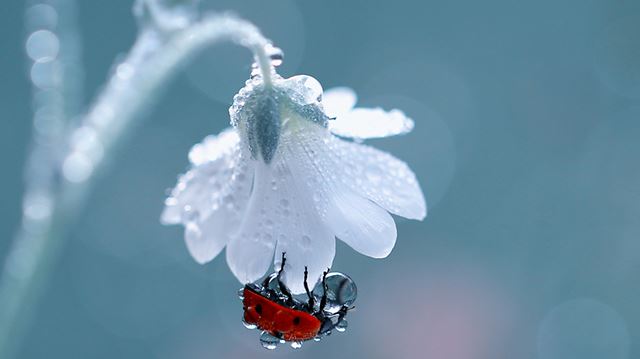
Make your own corner of the world a self-supporting eco-system with these tips from Francesca Clarke
If you’d like to make more sustainable and eco-friendly gardening choices, there are so many ways to turn. Literally every decision you take can make a difference, from the hard landscaping of paths and patios to the plants and planting design of your beds and borders.
If you’re looking for more tips and tricks, inspiration or breath-taking gardens, why not join us at the Eden Project this July? You’ll save on admission, receive a free guidebook and have the chance to enter a raffle to win fantastic Eden Project goodies – find out more here.
The way you deal with pests and diseases is, of course, hugely important, as is how you improve your soil and fertilise your crops and flowering plants.

Photo: Planting marigolds can help maintain the balance between beneficial and harmful insects in the garden
Hard landscaping first - what should I look out for?
 If you’re starting with a blank canvas or simply making changes to a patio, recycled materials are a good idea, as they reduce the exploitation of new resources. They can, however, have a high carbon footprint, so bear that in mind.
If you’re starting with a blank canvas or simply making changes to a patio, recycled materials are a good idea, as they reduce the exploitation of new resources. They can, however, have a high carbon footprint, so bear that in mind.
Sourcing timber from managed, renewable plantations is a wise option, as is reusing railway sleepers [pictured]. Permeability and drainage should be given careful consideration, too; for example, choose gravel laid over a weed-suppressing membrane instead of hard paving wherever possible.
Planting

Photo: Sunflowers will attract bees and birds, which, in turn, will help keep down natural pests like greenfly, slugs and snails
A sustainable garden can follow a formal layout, but most are more relaxed in style, with informal drifts of plants and mixes of grasses and perennials, native trees and shrubs.
Seedheads, flowers – throughout the seasons – and sheltering shrubs are so important for wildlife. Abundance is key, and a little mess is adored by nature. Remember, too, to plant according to your natural habitats: wetlands need moisture-loving species; woodland should be underplanted with shade-tolerant species.
The key design elements
 1 Water. If you have room, even the tiniest of ponds will create a habitat for a surprising amount of creatures, such as frogs, toads, dragonflies and newts, as well as a water source for birds and insects.
1 Water. If you have room, even the tiniest of ponds will create a habitat for a surprising amount of creatures, such as frogs, toads, dragonflies and newts, as well as a water source for birds and insects.
Make sure it has sloping sides and plant the margins with aquatics and you’re away.
2 A 'green roof' has to be up there as a great sustainable option. These systems manage rainwater run-off and provide insulation - they’re great either on a shed or large bike store and you’ll usually find them planted up with a variety of sedums.
3 A water butt is a must, however small. These days you’ll find any number of designs, ready to harvest water run-off from house and shed roofs.
4 Composting is gardening magic. Not only do you cut out waste but you feed your garden organically. Gather raw vegetable and fruit kitchen waste, plus old teabags and green clippings from the garden, pile them on a compost heap or into a bin, keep it moist, turn every now and then, and you’ll have the very best soil conditioner for free.
 5 A log stack left in the corner of the garden is a great place for all kinds of wildlife to shelter and breed. You may encourage overwintering frogs and toads, or even the rare stag beetle.
5 A log stack left in the corner of the garden is a great place for all kinds of wildlife to shelter and breed. You may encourage overwintering frogs and toads, or even the rare stag beetle.
What’s in it for me?

Photo: Encouraging birds to come to your garden will help control the wildlife looking to feed on your plants: snails, slugs, caterpillars, grubs
All of these measure mean you’re encouraging diversity in the form of natural predators into your garden, which will deal with pests such as greenfly, slugs and snails, so you won’t have to resort to chemicals.
Your garden will also be a magnet for pollinating insects such as bees and hoverflies, giving you more successful fruit and veg crops, and more flowers in your beds and borders.
For inspiration…
 Visit WWT London (pictured. wwt.org.uk) in Barnes SW13 to see first-hand what water in the garden can bring.
Visit WWT London (pictured. wwt.org.uk) in Barnes SW13 to see first-hand what water in the garden can bring.
Spend a day at Beth Chatto’s garden near Colchester in Essex (bethchatto.co.uk) to find out more about gardening hand in hand with nature on ecological principles.
Do more with Boundless
If you're working in or retired from the public sector or civil service, Boundless has two great membership options to choose from: Boundless and Boundless Plus.
With Boundless, you get unlimited access or discounted entry to many of the UK’s top attractions including Kew Gardens and Wakehurst and WWT centres across the UK, as well as year-round deals on restaurants, holidays, shopping and much more. With Boundless Plus, you can enjoy additional benefits including unlimited access to Historic Royal Palaces sites, National Trust for Scotland places, access to the Ramblers' extensive group walks and routes, and peace of mind with roadside assistance and local recovery by LV= Britannia Rescue.




